28. When the target moves
Obligingly, the moose comes clear. Bang! Flicking the Blaser rifle’s bolt, I’m back on target right away, the dot of the Aimpoint sweeping ahead of the shoulder, even with the ear. Bang! The moose is gone.
After a few more runs, right and left, the score comes up electronically. The Swede in the control house smiles sympathetically.
There’s no reason I shouldn’t garner a perfect score on this target. It is only 100 yards away, and though the bullseye is invisible from the line, it is in the logical place on the moose, and big enough to hit offhand. When the carriage moves, it is at a predictable speed, and smoothly. There’s no change of speed or direction, no brush in the way. Still, few shooters keep their bullets inside that five-spot. In fact, I lost one shot outside all the scoring circles and put several bullets in the three ring. Hardly a stellar performance for someone who’s been shooting rifles regularly for 35 years.

For shooting moving game at modest ranges, red dot sights excel. So do short, lightweight rifles.
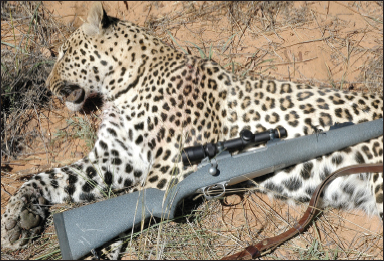
After a long trail, Wayne killed this leopard in tall grass with a quick 12-yard shot from his .375.
Hitting a moving target with a rifle is not so easy as some shooters would have you believe. One fellow told me he routinely killed running pronghorns at a quarter mile. But the next day he crippled a fine buck that was standing still as a post at 200 yards. Another fellow boasted of tumbling an elk on a dead run 300 yards off. A little probing revealed that his bullet clipped the skull, nearly 3 feet from where he had intended to hit. A couple of years ago, I watched a guide miss a wounded grizzly three times at less than 80 yards as it scampered across an open hillside.
The Swedes know that most riflemen think too highly of their own marksmanship, and that lucky hits simply encourage irresponsible shooting. That’s why a passable score on the moving moose target is a prerequisite for big game hunters in Sweden. It may not teach you how to hit running animals, but it will give you a healthy dose of humility.
I’m poorly qualified to write about shooting game on the run, because I avoid it. Actually, I started strong, with a one-shot kill on a whitetail streaking through aspens. Flushed with my achievement, I figured my keen eye and iron-sighted .303 were a match for anything on hooves. Then I repeatedly missed a buck waltzing across an alfalfa field, and a wounded deer scrambling for cover. I shot behind a pronghorn and well ahead of a blacktail buck close enough to nail with a beanbag.
Hitting with a rifle is harder than hitting with a shotgun because not only does your bullet lack the pancake-skillet breadth of a shot charge; it also lacks depth. A cloud of shot may be several feet long by the time it gets near the target. A lot of birds are killed by trailing pellets, so you can afford to be generous with lead. A bullet gives you no such latitude. You’re spot-on, or you miss.
With this mandate for precision, it’s easy to be stiff and tardy. Shooting moving game with a rifle calls for the same instant response and fluid body movement as using a shotgun. If you dawdle or interrupt your swing trying to refine that sight picture, you’ll miss, or lose your chance to shoot at all.
One deer hunter who taught me a lot about shooting in the woods said that it is like boxing: “Get your feet right first. The rest is easy.” He pointed out that many hunters fire at running deer before they get their balance, before they position their feet so the rifle comes naturally on-target. Easing through cover, he was careful to keep his weight over his feet and never get “twisted up.” With each step, he made sure he could shoot accurately in any direction a deer might appear, just by moving one foot. When he paused, it was always where he had good opportunities to shoot, but more importantly, where his feet could rest and pivot easily for a quick offhand shot. “Deer most often break cover when you stop moving,” he observed. “If you stop where your feet can’t help you shoot… well, that’s just dumb.”
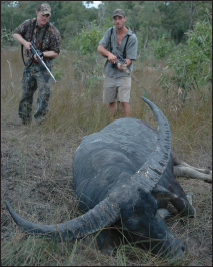
Jason Nash and his Australian guide approach a buffalo Jason downed with a Federal .375 load.
My mentor swung as gracefully with his little 6.5x55 carbine as with his favorite 20-bore double. His knees were bent slightly, most of his weight on the balls of his feet as he leaned into the rifle. “Prepare for the shot right away, even if it isn’t perfect—unless you’ve already decided to wait for the animal to stop or to appear in a better place. Once you’ve committed, follow through. Planting your feet, raising the rifle, setting your body in motion, focusing on the vitals and taking up trigger slack—that’s all part of a shot. The bang is just the finale.” He added that you can always abort at the last second because canceling a shot is easily done with the trigger finger alone.
Surely, it’s irresponsible to fling bullets at every running deer in range. But to swing tentatively is to miss. Forget about light brush. In timber, you should have a shot alley picked out before the butt strikes your shoulder. As soon as the sight sweeps in front of the target, the rifle ought to fire itself.
Try to apply the same discipline as when shooting at stationary game. I don’t shoot unless I think there’s a 90 percent chance my bullet will hit vitals. Making that decision instantly is part of shooting well at running game. There’s no disgrace in passing up a shot. But if you miss often, you’re probably shooting too often. When trees catch my bullets, I’m more generous with my scorecard than I am in open country, because in timber even dead-center shots will occasionally be short-stopped.
How much you lead an animal depends on its apparent speed (actual speed mitigated by the angle) and bullet flight time (distance x average velocity). A deer running straight away absolves you of lead, no matter the distance, because its path is in line with the bullet’s. A buck racing across your front at slingshot range requires almost no lead, if your swing is fast enough to keep the sight in the vitals, because bullet flight time is so short. To ranges of, say, 50 yards, your bullet should hit close enough to point of aim for a sure kill. Computing lead takes time; better to shoot fast squarely at the target.
As soon as that deer bursts into view, determine the lead based on what you know. Temper your instinctive urge to fire blindly. Think. Running deer up close seem jet-propelled, and your tendency is to snap-shoot. You generally have time for an aimed shot, and if you don’t, you have no shot at all. The same animal farther out requires more lead than you think. Like a goose in the distance, it appears to be cruising slowly. Steep shot angles at long range can require less lead than seems right, because you’re smitten by the animal’s actual speed and may not recognize its displacement relative to the bullet’s path.
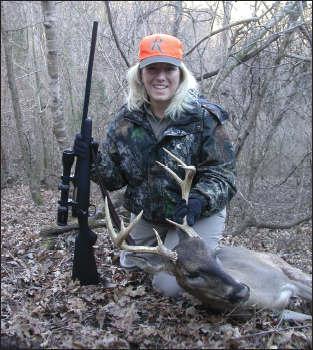
Linda Powell took this southeastern whitetail with her lightweight Remington bolt rifle.
To kill moving game regularly, you must move that rifle too! Your reaction time and the rifle’s lock time add to the bullet’s flight time to extend the lead you think is right. Also, the interval between your brain’s signal to fire and the striker’s release can vary. With a moving rifle, you have only flight time to fret about. If you prefer to “swing through” with a rifle moving fast enough to pass the target, you’ll have extra lead built in, so you won’t need as much air between sight and target as with a sustained lead.
Keep both eyes open. In concert, they’ll help you track the animal and maintain a sight picture. A squint handicaps you even when you’re shooting at still targets. More so when the game is moving.
I was once asked how much lead was required to tumble an elk running, at right angles, 20 mph at 200 yards, with a 180-grain bullet from a .30-06.
For a sustained lead, you calculate first the speed of the animal in feet per second. As anyone who took Driver Education when automobiles had bias-ply tires knows, a car traveling 60 mph moves 88 fps. So an elk at 20 mph covers about a third that distance—say, 30 feet—in one second. Chart velocity for a 180-grain .30-06 bullet is 2,700 fps. Now, because the bullet slows down as soon as it leaves the rifle, we must find its average speed over 200 yards to calculate its flight time. With a 200-yard speed of just over 2,300 fps, the bullet averages about 2,500 fps. But that’s a little skewed, because deceleration rate changes. Let’s put the real average at 2,450. A couple of hundred yards is 600 feet, so the bullet takes only a quarter-second to reach the bull. During that time, the elk travels a quarter of 30 feet, or about 7 ½ feet. So you’d aim 6 ½ feet ahead of the shoulder.
If the animal were running at a 45-degree angle, you’d halve the lead.
Here’s another example: Say you’re shooting a rifle chambered for the hot .338 Remington Ultra Mag, and on a moose hunt a bull with huge antlers trots across your front at 300 yards. It’s an open shot, and you’re sitting, with the rifle over a stump and steady enough for a smooth lead. But the bull is moving into a stiff 20-mph headwind. Your handloaded 210-grain Nosler exits the muzzle at 3,100 fps. Remember, though, that fast bullets decelerate faster than slow ones because they meet heavier air resistance. And that moose is covering ground at about 10 mph, or 15 fps. The math: Your bullet, averaging 2,700 fps, covers 300 yards (900 feet) in 1/3 second, during which time the target moves 5 feet. Your hold, then, should be four feet in front of the shoulder—if you were zeroed for 300 yards and there were no wind. But you rifle is zeroed, most properly, at 200 yards, so you’ll have to hold about 6 inches above where you want the bullet to hit. And since the 20-mph wind will drift your bullet back toward the animal, you must add the drift into your lead. That’s another foot. Swinging five feet ahead with the vertical wire, and keeping the horizontal just above center, you squeeze off.
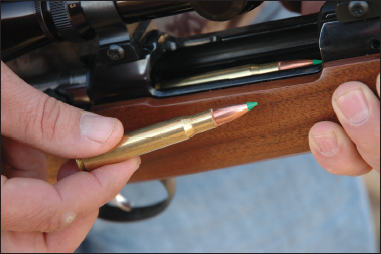
The centenarian .30-60 now boasts many loads adequate for the biggest North American game.

Getting to game is always more fun than shooting long. And the kills are more certain.
Then again, you may choose not to shoot at all. Long pokes, especially those that beg elevation or wind correction, are chancy when the target isn’t still. Truly, a 300-yard standing shot can be a challenge under most field conditions. If you aren’t sure, you’re smart to decline.
A running shot properly executed is a delightful thing, an accomplishment not soon forgotten. The fast, fluid moments up close—shots begun and finished in a heartbeat—are best of all. I’ve not made many. One I recall happened long ago, when a whitetail buck exploded from cover a few feet away. I fired as if at a partridge, decking the deer instantly. The entire episode lasted less than three seconds.
Another time, on the last day of a demanding quest for a big eland in Zimbabwe, my tracker and I happened upon a fresh track in dense thorn. We followed. As luck would have it, we had moved a scant hundred yards when an eland cow erupted from the cover. She vanished instantly. Then a huge eland bull burst into view at spitwad range. Phillip shouted something in Endebele that I took to mean “Shoot!” A patch of shoulder came clear for a millisecond as the scope field swept up from behind, a blur of eland and thorn. I fired with the memory of that shoulder in my mind’s eye; and a ton of hard-won trophy crashed to earth. The Core-Lokt bullet from my .300 Holland had broken the bull’s neck.
Such is the stuff a hunter’s dreams are made of. To make them come true, you must instantly pick your lead and shot alley. Point your feet. Stay balanced and fluid. Use both eyes. Swing smoothly. When your brain tells you the sight picture looks right, the only thing between you and success is delay.
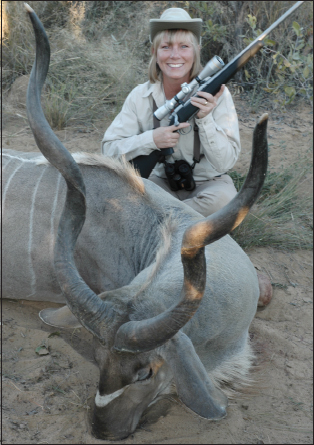
This Kudo fell to a shoulder shot, recovered, and required a finisher. Always be ready to follow up!
Table of contents
- Title Page
- Dedication
- Copyright
- Acknowledgments
- Foreword
- CONTENTS
- INTRODUCTION
- SECTION I: BALLISTICS IN HISTORY
- SECTION II: THE MUSCLE BEHIND THE SHOT
- SECTION III: BULLETS—THE INSIDE STORY
- SECTION IV: SPEED, ENERGY, AND ARC
- SECTION V : PUTTING BALLISTICS TO WORK
- SECTION VI: FOR LONGER REACH
- BALLISTICS TABLES FOR MODERN SPORTING RIFLES
- GLOSSARY